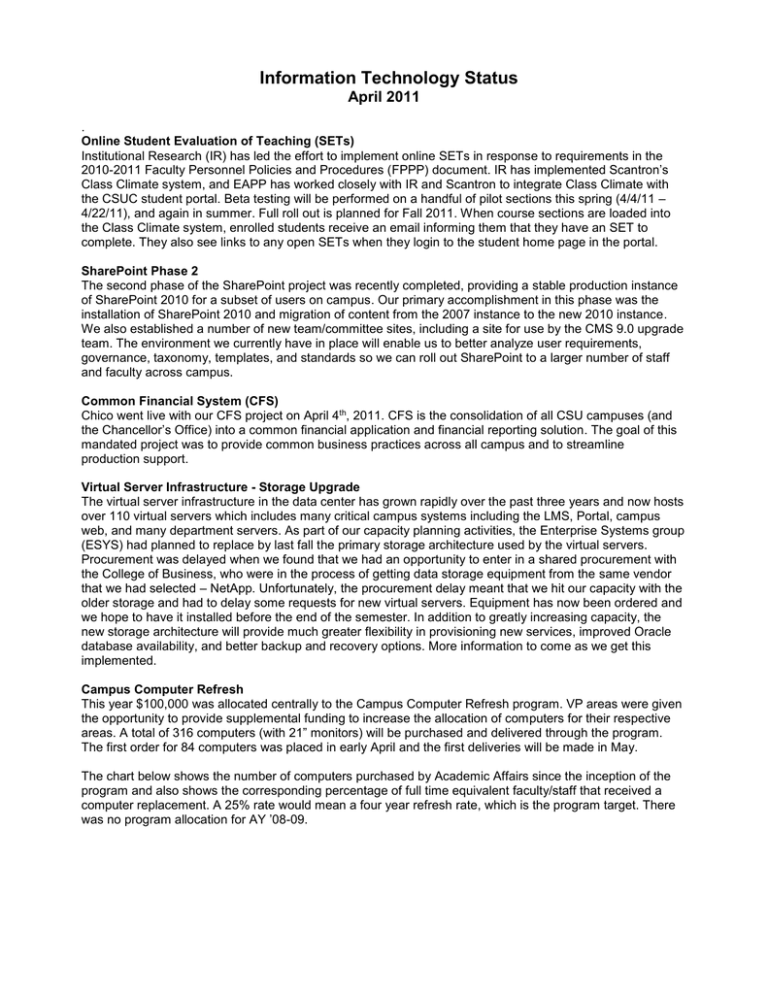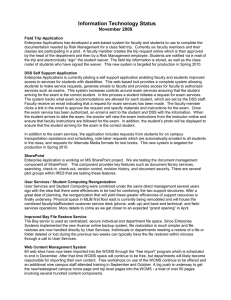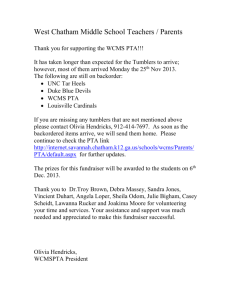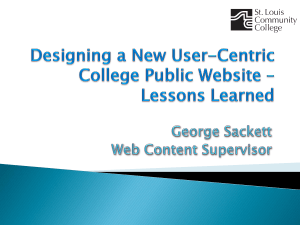Information Technology Status April 2011
advertisement

Information Technology Status April 2011 . Online Student Evaluation of Teaching (SETs) Institutional Research (IR) has led the effort to implement online SETs in response to requirements in the 2010-2011 Faculty Personnel Policies and Procedures (FPPP) document. IR has implemented Scantron’s Class Climate system, and EAPP has worked closely with IR and Scantron to integrate Class Climate with the CSUC student portal. Beta testing will be performed on a handful of pilot sections this spring (4/4/11 – 4/22/11), and again in summer. Full roll out is planned for Fall 2011. When course sections are loaded into the Class Climate system, enrolled students receive an email informing them that they have an SET to complete. They also see links to any open SETs when they login to the student home page in the portal. SharePoint Phase 2 The second phase of the SharePoint project was recently completed, providing a stable production instance of SharePoint 2010 for a subset of users on campus. Our primary accomplishment in this phase was the installation of SharePoint 2010 and migration of content from the 2007 instance to the new 2010 instance. We also established a number of new team/committee sites, including a site for use by the CMS 9.0 upgrade team. The environment we currently have in place will enable us to better analyze user requirements, governance, taxonomy, templates, and standards so we can roll out SharePoint to a larger number of staff and faculty across campus. Common Financial System (CFS) Chico went live with our CFS project on April 4th, 2011. CFS is the consolidation of all CSU campuses (and the Chancellor’s Office) into a common financial application and financial reporting solution. The goal of this mandated project was to provide common business practices across all campus and to streamline production support. Virtual Server Infrastructure - Storage Upgrade The virtual server infrastructure in the data center has grown rapidly over the past three years and now hosts over 110 virtual servers which includes many critical campus systems including the LMS, Portal, campus web, and many department servers. As part of our capacity planning activities, the Enterprise Systems group (ESYS) had planned to replace by last fall the primary storage architecture used by the virtual servers. Procurement was delayed when we found that we had an opportunity to enter in a shared procurement with the College of Business, who were in the process of getting data storage equipment from the same vendor that we had selected – NetApp. Unfortunately, the procurement delay meant that we hit our capacity with the older storage and had to delay some requests for new virtual servers. Equipment has now been ordered and we hope to have it installed before the end of the semester. In addition to greatly increasing capacity, the new storage architecture will provide much greater flexibility in provisioning new services, improved Oracle database availability, and better backup and recovery options. More information to come as we get this implemented. Campus Computer Refresh This year $100,000 was allocated centrally to the Campus Computer Refresh program. VP areas were given the opportunity to provide supplemental funding to increase the allocation of computers for their respective areas. A total of 316 computers (with 21” monitors) will be purchased and delivered through the program. The first order for 84 computers was placed in early April and the first deliveries will be made in May. The chart below shows the number of computers purchased by Academic Affairs since the inception of the program and also shows the corresponding percentage of full time equivalent faculty/staff that received a computer replacement. A 25% rate would mean a four year refresh rate, which is the program target. There was no program allocation for AY ’08-09. AA Faculty/Staff Computer Refresh # Computers and % FTE by Year 400 32% 31% 25% 300 22% 22% 21% 250 200 27% 26% 25% 17% 360 304 150 306 320 271 12% 278 100 7% % of FTE # Computers Replaced 350 2% 50 0 0 -3% 04-05 05-06 06-07 07-08 Computers Web Content Management and Web Accessibility The Web Content Management System (WCMS) project started about two years ago, with two main goals: 1) to improve the consistency and ease of maintenance of campus web pages, and 2) to enforce web accessibility standards as required by the system-wide Accessible Technology Initiative (ATI). The WCMS project was considered complete as of the end of 2010 (the use of the WCMS will be ongoing, but the main effort to move web sites to the WCMS is complete). At this time approximately 40% of the 26,000 total campus web pages are in the WCMS. Almost all of the web pages that are “eligible” to go into the WCMS are now there. Most of the remaining 60% are currently “ineligible” to move to the WCMS because they are managed by external vendors or are based on technology that makes it very difficult to move into the WCMS. The chart at right shows that moving content into the WCMS has been very effective in enabling web accessibility compliance. Nearly all content in the WCMS is accessible whereas almost all of the web content still inaccessible is outside the WCMS. However, a significant number of the “failing” pages are archival or seldom-accessed, e.g. old newsletters, announcements, and articles. 08-09 09-10 10-11 % of FTE WCMS Status - March 2011 Pages in WCMS 10,545 WCMS Eligible Pages 15,125 WCMS Ineligible Pages 320 Web Page Accessibility - March 2011 20.6% 40.1% WCMS pass WCMS fail Non-WCMS pass Non-WCMS fail 38.8% 0.4%


